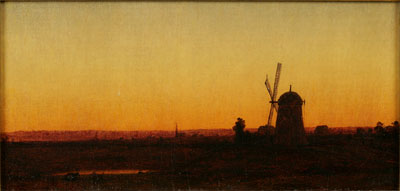
And Then There Was Light
The art and collection of James A. Suydam at the National Academy Museum
by Maureen Mullarkey
"LABELS ARE THE DICKENS." So complained John Bauer, who coined the noun “luminism” in an influential 1954 essay entitled “American Luminism, a Neglected Aspect of the Realist Movement in Nineteenth-Century American Painting.”
 |
| James A. Suydam, Twilight with Windmill |
In preceding years, Bauer tried out other terms, initially citing James Suydam as a “tonal realist.” His 1950 article on Suydam was the only existing monograph on the artist prior to the one which now accompanies “Luminist Horizons: The Art and Collection of James A. Suydam” at the National Academy Museum.
Luminism is an enigmatic word that has suffered various definitions, all centered on American artists’ ongoing attention to qualities of light and atmosphere. Dan Flavin’s contemporary neon constructions enjoy the label as easily as Suydam’s silvery views of Newport Beach. Used here, the word covers the shared practice of a closely related group of painters of which Suydam was an integral part during the 1850s and 1860s.
James Augustus Suydam (1819–1865) was the son of one of New York’s early Dutch merchant families, part of the Knickerbocker aristocracy. He completed medical studies at the University of the City of New York (now N.Y.U.) but never practiced medicine, finding art and architecture more compatible. An inheritance acquired after his father’s death in 1841 permitted him to become both a patron of the arts and, in his thirties, a painter as well.
Suydam exhibited between 1856 and 1865, pivotal years of development for American landscape painting. He kept a studio in the Tenth Street Studio Building, unofficial headquarters of the Hudson River School, where he made friends with other members and collected their work. That collection, bequeathed to the National Academy, established the nucleus of its permanent collection of 19th century art.
Suydam showed work at the National Academy of Design for the first time in 1856, becoming an Academician himself five years later. Soon elected to the Academy’s governing body, he served until his death, raising money for the Academy’s first home on Fourth Avenue and 23rd Street. He contributed generously to its Fellowship Fund and attracted other wealthy supporters sensitive to America’s patrimony.
Bauer’s struggle with terminology continues in the accompanying catalog, co-authored by art historian Katherine Mansthorne and Mark Mitchell, assistant curator of 19th century painting at the National Academy. Finding a language for luminism bedevils the text when it strays from the paintings themselves. That is too bad because the exhibition is a first-rate pleasure that earns looking at for its own sake, not merely for purposes of “rehabilitating Luminism.” Vindicating terms is a minor ambition that serves the art market and the publish-or-perish clerisy ahead of the viewing public.
Put simply, this is a radiant show of intelligent work by a gifted man who was an admirably fresh painter if a more conventional collector. Works by Frederic Church, John Kensett, Sanford Gifford, William Hart, and Jasper Cropsey crown a collection that includes many genre scenes and sentimental portraits (e.g. “The Fainting Spell,” “The Fair Penitent”) that no longer resonate.
Suydam’s mastery of landscape conditions and moods is especially impressive given the brief time he had to develop his hand. The still waters and incandescent skies of “Twilight, Salt Lake, Narragansett" (c.1858) or a limpid 1862 shoreline view of Long Island demonstrate full maturity. Suydam’s centered horizon lines limit expanses of sky, a compositional brake on Hudson River School reach for the sublime. His relation to light is intimate and empathetic. Familiarity and modesty displace awe and define his approach. The sublime surrenders to the lightsome serenity of a particular place and moment — the keynote of American luminism.
Suydam’s considerable achievement as a painter is undercut by the catalog’s class-conscious condescension. Where the authors stay close to the paintings and Suydam’s collaborative circle of painters, they are helpful. But the catalog is anxious to emphasize his status as a “painter-amateur,” insinuating an intrinsic link between private income and amateurism. It takes leave of the art to drift into literary allusions that deprecate the artist as a “moneyed man of leisure, superfluous and even distasteful to the majority of his countrymen.”
A Marxoid drip, filtered through repetition of the word amateur, seeps through the text like a corrosive salt. It tells us more about the present state of American art history than about Suydam
Suydam’s livelihood was, indeed, independent of sales (as was that of his colleague Church). At the same time, he painted well and helped guarantee the future of the National Academy. We would be spared much academic musing about “the amateur’s contract with society” if bush- league Marxists would just remember the subtext of the gospel story of the Good Samaritan — the man had money in his pocket. Who knows, he might have been a damn fine painter, too.




“Luminist Horizons: The Art and Collection of James A. Suydam” at the National Academy Museum (1083 Fifth Ave., 212-369-4880).
This review first appeared in The New York Sun, September 21, 2006.
Copyright 2006, Maureen Mullarkey







